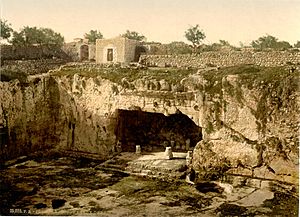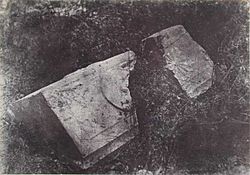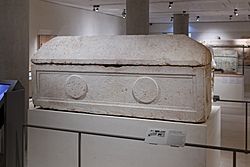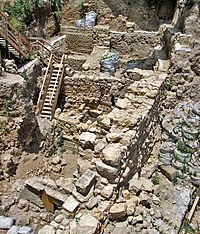Helena of Adiabene facts for kids
Quick facts for kids Helena of Adiabene |
|
|---|---|
| Queen of Adiabene and Edessa | |
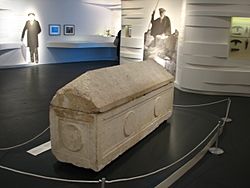
Sarcophagus of Helena, Israel Museum
|
|
| Died | 50–56 CE |
| Burial | Jerusalem |
| Spouse | Monobaz I and Abgar V |
| Issue | Izates bar Monobaz and Monobaz II |
| Religion | Convert to Judaism |
Helena of Adiabene (Hebrew: הִילְנִי Hīlənī; d. ca. 50–56 CE) was a queen mother of the Parthian vassal state of Adiabene (modern-day Erbil, Iraqi Kurdistan). With her husband and brother Monobaz I, she was the mother of Izates II and Monobaz II. Helena became a convert to Judaism about the year 30 CE. According to Josephus, Helena was the daughter of King Izates. Moses of Chorene makes her the chief wife of Abgar V, king of Edessa.
Biography
Helena of Adiabene was noted for her generosity; during a famine at Jerusalem in 45–46 CE she sent to Alexandria for corn (grain) and to Cyprus for dried figs for distribution among the sufferers from the famine. In the Talmud, however (Bava Batra 11a), this is laid to the credit of Monobaz I; and though Brüll regards the reference to Monobaz as indicating the dynasty, still Rashi maintains the simpler explanation—that Monobaz himself is meant. The Talmud speaks also of important presents which the queen gave to the Temple at Jerusalem. "Helena had a golden candlestick made over the door of the Temple," to which statement is added that when the sun rose its rays were reflected from the candlestick and everybody knew that it was the time for reading the Shema'. She also made a golden plate on which was written the passage of the Pentateuch. In the Jerusalem Talmud, tractate Yoma iii. 8 the candlestick and the plate are confused.
The strictness with which she observed the Jewish law is instanced in the Talmud:
- "Her son [Izates] having gone to war, Helena made a vow that if he should return safe, she would become a Nazirite for the space of seven years. She fulfilled her vow, and at the end of seven years went to Judea. Those belonging to the School of Hillel told her that she must observe her vow anew, and she therefore lived as a Nazirite for seven more years. At the end of the second seven years she became ritually impure by corpse uncleanness, and she had to repeat her Naziriteship, thus being a Nazarite for twenty-one years. Judah bar Ilai, however, said she was a Nazirite for fourteen years only."
"Rabbi Judah said: 'The sukkah [erected for the Feast of Tabernacles] of Queen Helena in Lydda was higher than twenty ells. The rabbis used to go in and out and make no remark about it'." Helena moved to Jerusalem, where she is buried in the pyramidal tomb which she had constructed during her lifetime, three stadia north of Jerusalem. The catacombs are known as "Tombs of the Kings." A sarcophagus bearing two inscriptions was found there, the funerary epigram reading: Ṣaddan Malkata (Palmyrene: 𐡲𐡣𐡭 𐡬𐡫𐡪𐡶𐡠), and Ṣaddah Malkatah (Aramaic: צדה מלכתה), interpreted by scholars to mean: "Our mistress, the Queen." The sarcophagus of Queen Helena of Adiabene.was discovered by Louis Felicien de Saulcy in the nineteenth century; although he believed the bones inside, wrapped in shrouds with golden embroidery, were the remains of the wife of a king of Judea from the First Temple period, possibly Zedekiah or Jehoash. De Saulcy was forced to suspend the dig when the news that human bones were being dug up drew the ire of the Jewish community of Jerusalem. The sarcophagus and other findings were sent to France and displayed at the Louvre.
Jerusalem palace of the Adiabenes
The royal palace of Queen Helena is believed to have been discovered by archaeologist Doron Ben-Ami during excavations in the City of David in 2007. According to Josephus, the palace was built by (the otherwise unknown) "Grapte, a kinswoman" of Izates. It was a monumental building located in the City of David just to the south of the Temple Mount and was destroyed by the Romans in 70 CE. The ruins contained datable coins, stone vessels and pottery as well as remnants of ancient frescoes. The basement level contained a mikveh (ritual bath).
See also
 In Spanish: Helena de Adiabene para niños
In Spanish: Helena de Adiabene para niños


